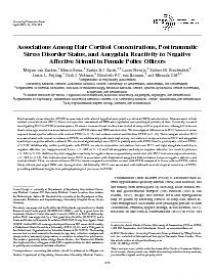Associations Among Hair Cortisol Concentrations, Posttraumatic Stress Disorder Status, and Amygdala Reactivity to Negative Affective Stimuli in Female Police Officers
Posttraumatic stress disorder (PTSD) is associated with altered hypothalamic-pituitary-adrenal (HPA) axis function. Measurement of hair cortisol concentrations (HCC) allows retrospective assessment of HPA axis regulation over prolonged periods of time. Currently, research investigating HCC in PTSD remains sparse. Previous cross-sectional studies have included only civilian populations, although it is known that trauma type moderates associations between PTSD status and HPA axis function. We investigated differences in HCC between traumaexposed female police officers with current PTSD (n = 13) and without current and lifetime PTSD (n = 15). To investigate whether HCC was associated with neural correlates of PTSD, we additionally performed exploratory correlational analyses between HCC and amygdala reactivity to negative affective stimuli. We observed significantly lower HCC in participants with PTSD than in participants without PTSD, d = 0.89. Additionally, within participants with PTSD, we observed positive correlations between HCC and right amygdala reactivity to negative affective (vs. happy/neutral) faces, r = .806 (n = 11) and left amygdala reactivity to negative affective (vs. neutral) pictures, r = .663 (n = 10). Additionally, left amygdala reactivity to negative faces was positively correlated with HCC in trauma-exposed controls, r = .582 (n = 13). This indicates that lower HCC is associated with diminished amygdala differentiation between negative affective and neutral stimuli. Thus, we observed lower HCC in trauma-exposed noncivilian women with PTSD compared to those without PTSD, which likely reflects prolonged HPA axis dysregulation. Additionally, HCC was associated with hallmark neurobiological correlates of PTSD, providing additional insights into pathophysiological processes in PTSD.
Geachte bezoeker,
De informatie die u nu opvraagt, kan door psychotraumanet niet aan u worden getoond. Dit kan verschillende redenen hebben,
waarvan (bescherming van het) auteursrecht de meeste voorkomende is. Wanneer het mogelijk is om u door te verwijzen naar de bron
van deze informatie, dan ziet u hier onder een link naar die plek.
Als er geen link staat, kunt u contact opnemen met de bibliotheek,
die u verder op weg kan helpen.
Met vriendelijke groet,
Het psychotraumanet-team.
In: Journal of Traumatic Stress ISSN: 1573-6598 | 32 | 2 | april | 238-248
https://doi.org/10.1002/jts.22395


